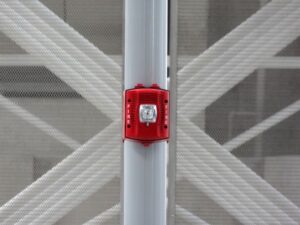
Fire alarm systems are essential in ensuring fire safety in any building or commercial property by detecting and notifying building occupants about occurring emergencies.
Fire alarm systems are essential in ensuring fire safety in any building or commercial property by detecting and notifying building occupants about occurring emergencies. They consist of many different components, devices, and features, making them quite complex and sophisticated. Here are five basic components of fire alarm systems, their purpose, and how they function.
Fire Alarm Control Panel (FACP)
The fire alarm control panel functions as the central brain of your entire fire alarm and detection system. It monitors and controls the systems initiation devices. When an initiation device is triggered, it sends a signal to the control panel, which activates the notification devices or the alarm. The control panel also allows you to manually control the system and check the status of your system, so you can detect issues when they occur.
Fire Alarm Initiating Devices
Initiating devices are responsible for activating the system in an emergency. There are two categories of initiating devices, including manual and automatic. Manual initiating devices require you to pull a switch or handle to initiate the alarm physically. Automatic initiation devices activate automatically upon detecting heat, smoke, flames, or gas. Listed below are types of initiation devices, both manual and automatic:
- Pull stations
- Alarm buttons
- Duct detectors
- Smoke detectors
- Beam detectors
- Heat detectors
- Flame detectors
- Tamper switches
- Air aspirating detectors
- CO2 detectors
If you are unsure which initiating device works best for you and your property’s needs, your fire alarm system provider can help.
Fire Alarm Notification Devices
Notification devices notify building occupants that a fire or emergency has been detected. They can be programmed to deliver visual and audible messages relevant to different emergencies and should include:
- Strobes
- Alarms
- Bells
- Horns
- Sirens
- Chimes
- Voice Evacuation
Primary Power Supply
The majority of fire alarm systems need a primary and backup power supply. The primary power supply usually comes from a 120- or 240- Volt AC power source that your property’s power company supplies.
Backup Power Supply
As mentioned above fire alarm system also need a backup power supply just in case the primary power fails or is shut off. A backup power supply will typically consist of 6- or 12- volt batteries to ensure your fire alarm system continues to run when the primary power is out.
Contact Chesapeake Sprinkler Company Today!
Chesapeake Sprinkler Company is a leading fire sprinkler contractor in the region. As a full-service fire protection company, we offer design, fabrication, installation, testing, maintenance, and inspection of fire protection systems. Everything you need from your fire suppression specialist.
For more information, please email or call our Odenton location at 410-674-7041, our Ashburn location at 703-729-5150, or for service/maintenance Chesapeake Protection Services at 410-674-7577. For emergencies, call 800-298-3473 (FIRE). Feel free to keep in touch through Facebook, Twitter, or LinkedIn!
